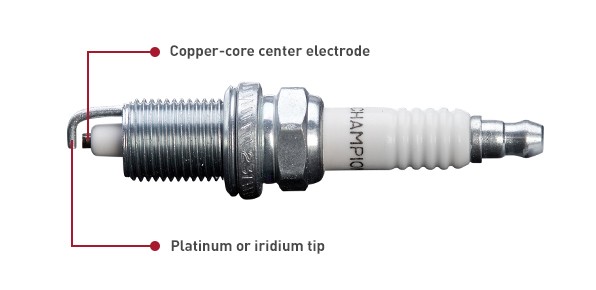There are only three things you need to make an engine run: Fuel, Air, and Spark. The spark comes from spark plugs and without a spark, your engine simply won’t run. The spark plug is what creates an electrical arc to light the fuel and air mixture inside the cylinder to create combustion.
Not all spark plugs are created equal just as not all engines are created equal. While the general theory of spark plugs remains the same, they can be made out of different components, have different designs, and have different usages.
Different Types Of Spark Plug Materials
There are several types of spark plugs, including:
Copper spark plugs: traditional and economical option.
Iridium spark plugs: have a fine wire center electrode made of iridium, providing better performance and a longer lifespan than copper plugs.
Platinum spark plugs: similar to iridium but with a platinum center electrode, offer better durability and longer lifespan.
Double platinum spark plugs: have platinum on both the center electrode and ground electrode for better durability and longer lifespan.
Nickel spark plugs: made with a nickel center electrode, offer good corrosion resistance and thermal conductivity.
Laser welded spark plugs: have a laser-welded center electrode for improved durability and better performance in high-performance engines.
Fine wire spark plugs: have a finer center electrode that provides improved ignition and fuel efficiency in high-performance engines.
It’s essential to choose the right type of spark plug for your vehicle, considering factors such as engine type, operating conditions, and manufacturer recommendations.
Flat Vs Tapered Spark Plug Designs
Flat seat and tapered seat spark plugs are two different types of spark plugs that are designed to fit different types of engines and applications. Here are some key differences between the two types of spark plugs:
Seat design: Flat seat spark plugs have a flat surface at the base of the spark plug, where the spark plug meets the cylinder head. Tapered seat spark plugs have a tapered surface at the base of the spark plug.
Installation: Flat seat spark plugs are installed using a torque wrench to apply a specific amount of torque to the spark plug. Tapered seat spark plugs are installed by hand and do not require a torque wrench.
Tightening method: Flat seat spark plugs use a torque-based tightening method, while tapered seat spark plugs use a friction-based tightening method.
Compression seal: Flat seat spark plugs create a compression seal with the cylinder head using the flat seat surface, while tapered seat spark plugs create a seal using the tapered seat surface.
Compatibility: Flat seat spark plugs are generally compatible with engines that have flat seat spark plug wells, while tapered seat spark plugs are generally compatible with engines that have tapered seat spark plug wells.
Performance: Flat seat spark plugs are generally considered to be more durable and reliable than tapered seat spark plugs, as they create a more secure seal with the cylinder head and are less prone to loosening or vibrational issues. However, tapered seat spark plugs may improve ignition performance in certain engines.
Overall, the choice between flat seat and tapered seat spark plugs will depend on the specific requirements of the engine and the application.

Hot And Cold Spark Plug Differences
Hot and cold spark plugs are two types of spark plugs that are designed to operate at different temperature ranges. A simple SBC is going to use a different heat range of plug than a high-compression BBC, which will use a different plug than a twin-turbo LS engine.
Operating temperature range: Hot spark plugs are designed to operate at higher temperature ranges and are typically used in high-performance or high-compression engines. Cold spark plugs are designed to operate at lower temperature ranges and are typically used in standard or low-compression engines.
Heat range: The heat range of a spark plug refers to its ability to dissipate heat. Hot spark plugs have a higher heat range and are able to dissipate heat more effectively, while cold spark plugs have a lower heat range and are less able to dissipate heat.
Material: Hot spark plugs are typically made from materials that are able to withstand higher temperatures, such as iridium or platinum, while cold spark plugs may be made from materials such as copper or nickel.
Performance: Hot spark plugs are generally used in engines that generate higher levels of heat and combustion pressure, as they are able to withstand higher temperatures and maintain their performance. Cold spark plugs are generally used in engines that generate lower levels of heat and combustion pressure, as they are able to operate effectively at lower temperatures.
Overall, the choice between hot and cold spark plugs will depend on the specific requirements of the engine and the operating conditions. It is important to choose the correct type of spark plug to ensure optimal performance and reliability.

Which plug is right for your engine can be easily determined if the engine is stock or fairly stock; go with the OEM recommended plug. If you have a built engine, it’s better to ask the engine builder which heat range and type of plug to use for optimal performance with your engine. If you have any other questions give our friendly techs a call at (203) 235-1200 or visit SS396.com





